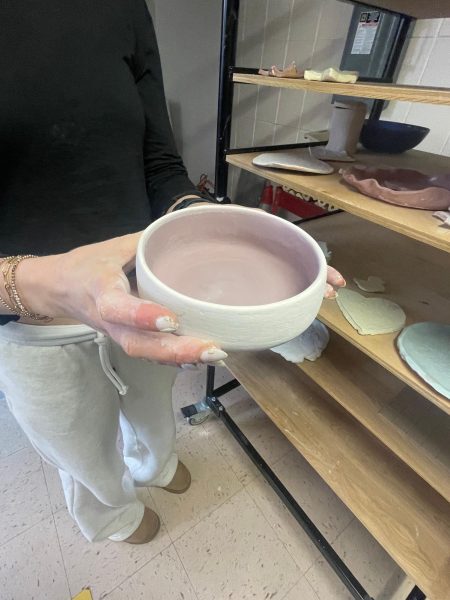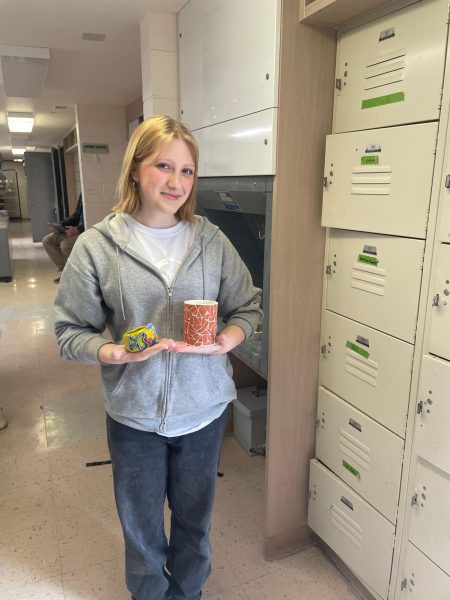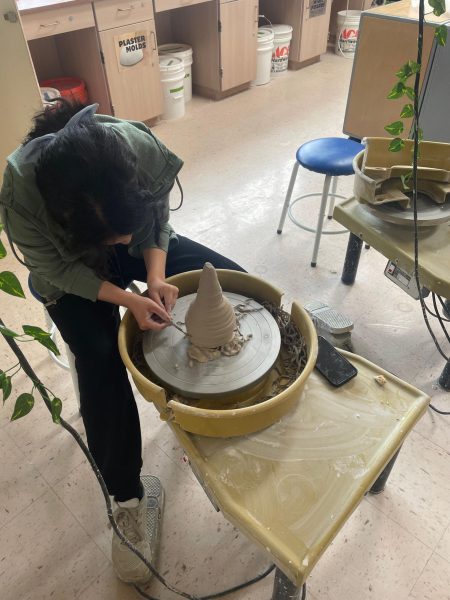Walking into Room 203 during Period 6, visitors see students busy at work, sculpting various projects from clay. Around 20 beginners with no ceramics background work side by side with a handful of students who have years of experience.
Rodriguez teaches multiple levels of ceramics, including Ceramics 1, 2, 3 and AP 3-D Art and Design, all across two periods: 4 and 6
This mix of classes isn’t easy, but ceramics teacher Nikki Rodriguez makes it work.
She emphasizes the importance of differentiation between students in her teaching style.
“No matter, even if it’s a mixed level class, students will have a really wide range of skills that they’re bringing into the class,” Rodriguez said. “It’s all about meeting students where they are and making sure that those that need a bit more time and those that need challenges have that.”
Every day, Rodriguez posts a general plan for the class on the board, detailing the different projects students’ in each art level will be working on. She rarely does whole-class instruction, but insteads checks in with each student individually, offering advice and guidance to whatever art piece they are working on.
“There’s definitely a lot of benefits when everyone is combined but some difficulties would be the pressure on me to make sure that all students are feeling that their needs are met, which is really important to me,” said Rodriguez, who is now in her second year teaching at the school.
In Ceramics 2, 3 and AP, students are given more advanced projects and are expected to work with greater detail and effort, reflecting their higher skill level.


These students also have the opportunity to use a pottery wheel, a central tool in their work which allows for increased efficiency and a more consistent shape. The pottery wheel helps students maintain an even thickness on their sculptures, unlike handbuilding large objects, which can lead to more uneven results.

Ceramics 1 students are not allowed to use the pottery wheel until the second semester, and only after they’ve learned basic techniques such as centering the clay, pulling up the walls and shaping the piece. These lessons are crucial for mastering the skills necessary to create more intricate pieces. Meanwhile, the more advanced students are already proficient in these techniques and are given more freedom to explore their creativity.
Because some students advance through the levels — moving from Ceramics 1 to Ceramics 2, 3, and AP — Rodriguez ensures that the projects remain new, so returning students can do something different each year.
Since AP 3-D Art and Design students have to submit a portfolio detailing their work in May, they do not follow the rest of the class. Instead, they create their own “inquiry” or research question, so they have full control of what they make in the year-long development of their portfolio. Most students create their projects using ceramics, though they have the freedom to explore other sculptural mediums as well.
According to junior Charlotte Hu, who is in Ceramics 1, the varied skill levels are a benefit as new students can be inspired by the advanced students’ work, encouraging them to take on more ambitious projects. Additionally, advanced students are more than willing to help their peers if they are struggling.
“It’s fun looking at how [more advanced students] make projects and sometimes I ask for help from them. I like how it’s all together because then students are able to collaborate with each other,” Hu said.
As an AP 3-D art and design student, senior Chloe Mantle has been working on projects that differ from the rest of the class. She reflects on how the creative freedom in this class is much greater compared to her previous ceramics classes. Ceramics 1, 2 and 3 have set projects every unit, but in the AP class, she has the opportunity to explore and test her creativity. The projects go beyond what is taught in ceramics 1.
While other students are focused on throwing on the wheel and making simple bowls, Mantle challenges herself by experimenting with more complex techniques, like emulating the TikTok famous Nara Smith bubble plate. She also appreciates having a diverse group of students in her class because it is a valuable experience, where students have many sources of help and guidance if needed.
“I really enjoy the atmosphere of the class and the amount of freedom there is. There’s less structure as to what exactly you have to make, so it really pushes you to be more creative,” Mantle said. “I have to try and find new interesting ways to make my pieces fit into my portfolio and make everything cohesive”.